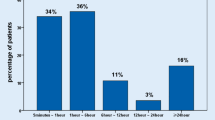Abstract
Purpose
Despite the use of steroid-eluting leads, a transient but not persistent rise in the atrial/ventricular capture threshold (TRACT/TRVCT) can occur early after pacemaker implantation in patients with sick sinus syndrome. This study aimed to assess the prevalence, predictors, and mechanisms of TRACT/TRVCT in patients with heart failure undergoing implantable cardioverter defibrillator (ICD) or cardiac resynchronization therapy (CRT) implantation.
Method
One hundred twenty consecutive patients underwent ICD (N = 70) or CRT (N = 50) implantation. Capture threshold was measured at implantation, 7-day, 1-month, and 6-month post-implantation. TRACT/TRVCT was defined as a threshold rise at 7 days by more than twice the height of the threshold at implantation, with full recovery during follow-up. Atrial and brain natriuretic peptide (ANP and BNP) levels were measured before implantation.
Results
TRACT and TRVCT were observed in 13 (11%) and 10 (8%) patients, respectively. Patients with TRACT had lower ANP level (median 72 [42–105] vs. 99 [49–198] pg/mL, P = 0.06), lower ANP/BNP ratio (0.29 [0.20–0.36] vs. 0.50 [0.33–0.70], P < 0.01), lower atrial sensing amplitude (2.0 ± 0.8 vs. 2.7 ± 1.3 mV, P = 0.02), and lower left ventricular ejection fraction (32 ± 12 vs. 40 ± 14%, P = 0.04) than those without TRACT. TRACT recovered within 1 month, whereas TRVCT recovered within 6 months. In multivariable analysis, ANP/BNP ratio was the only independent predictor of TRACT (OR, 0.018; 95% CI, 0.001–0.734; P = 0.034).
Conclusions
Atrial degenerative change characterized by lower ANP/BNP ratio was associated with the occurrence of TRACT in patients with heart failure. TRVCT could also occur, but it required a longer recovery time than TRACT.



Similar content being viewed by others
Abbreviations
- ANP:
-
Atrial natriuretic peptide
- BNP:
-
Brain (B-type) natriuretic peptide
- CRT-D (P):
-
Cardiac resynchronization therapy defibrillator (pacemaker)
- ICD:
-
Implantable cardioverter defibrillator
- LVEF:
-
Left ventricular ejection fraction
- SSS:
-
Sick sinus syndrome
- TRACT:
-
Transient rise in the atrial capture threshold
- TRVCT:
-
Transient rise in the ventricular capture threshold
References
Udo EO, Zuithoff NP, van Hemel NM, et al. Incidence and predictors of short- and long-term complications in pacemaker therapy: the FOLLOWPACE study. Heart Rhythm. 2012;9:728–35.
Mond HG, Helland JR, Stokes K, et al. The electrode-tissue interface: the revolutionary role of steroid-elution. Pacing Clin Electrophysiol. 2014;37:1232–49.
Kimata A, Yoshida K, Takeyasu N, et al. Bradycardia-dependent rise in the atrial capture threshold early after cardiac pacemaker implantation in patients with sick sinus syndrome. HeartRhythm Case Rep. 2015;2:27–31.
Uehara Y, Yoshida K, Kimata A, Ogawa K, Abe D, Tsumagari Y, et al. Underrecognized entity of the transient rise in the atrial capture threshold early after dual-chamber pacemaker implantation. Pacing Clin Electrophysiol. 2017;40:1396–404.
Pfisterer M, Buser P, Rickli H, Gutmann M, Erne P, Rickenbacher P, et al. BNP-guided vs symptom-guided heart failure therapy: the trial of intensified vs standard medical therapy in elderly patients with congestive heart failure (TIME-CHF) randomized trial. JAMA. 2009;301:383–92.
Schaub JA, Coca SG, Moledina DG, Gentry M, Testani JM, Parikh CR. Amino-terminal pro-B-type natriuretic peptide for diagnosis and prognosis in patients with renal dysfunction: a systematic review and meta-analysis. JACC Heart Fail. 2015;3:977–89.
van den Berg MP, van Gelder IC, van Veldhuisen DJ. Depletion of atrial natriuretic peptide during longstanding atrial fibrillation. Europace. 2004;6:433–7.
van den Berg MP, Tjeerdsma G, Jan de Kam P, et al. Longstanding atrial fibrillation causes depletion of atrial natriuretic peptide in patients with advanced congestive heart failure. Eur J Heart Fail. 2002;4:255–62.
Yoshihara F, Nishikimi T, Sasako Y, Hino J, Kobayashi J, Minatoya K, et al. Plasma atrial natriuretic peptide concentration inversely correlates with left atrial collagen volume fraction in patients with atrial fibrillation: plasma ANP as a possible biochemical marker to predict the outcome of the maze procedure. J Am Coll Cardiol. 2002;39:288–94.
Yoshida K, Tada H, Ogata K, Sekiguchi Y, Inaba T, Ito Y, et al. Electrogram organization predicts left atrial reverse remodeling after the restoration of sinus rhythm by catheter ablation in patients with persistent atrial fibrillation. Heart Rhythm. 2012;9:1769–78.
Nakanishi K, Fukuda S, Yamashita H, Kosaka M, Shirai N, Tanaka A, et al. Pre-procedural serum atrial natriuretic peptide levels predict left atrial reverse remodeling after catheter ablation in patients with atrial fibrillation. JACC Clin Electrophysiol. 2016;2:151–8.
Fujita S, Shimojo N, Terasaki F, Otsuka K, Hosotani N, Kohda Y, et al. Atrial natriuretic peptide exerts protective action against angiotensin II-induced cardiac remodeling by attenuating inflammation via endothelin-1/endothelin receptor A cascade. Heart Vessel. 2013;28:646–57.
Lee S, Wellens HJ, Josephson ME. Paroxysmal atrioventricular block. Heart Rhythm. 2009;6:1229–34.
Davis LD. Effects of autonomic neurohumors on transmembrane potentials of atrial plateau fibers. Am J Phys. 1975;229:1351–6.
Hasebe H, Yoshida K, Iida M, Hatano N, Muramatsu T, Nogami N, Aonuma K. Differences in the structural characteristics and distribution of epicardial adipose tissue between left and right atrial fibrillation. Europace. 2018;20:435–42.
Yoshida K, Hattori A, Tsuneoka H, Tsumagari Y, Yui Y, Kimata A, et al. Electrophysiological relation between the superior vena cava and right superior pulmonary vein in patients with paroxysmal atrial fibrillation. J Cardiovasc Electrophysiol. 2017;28:1117–26.
Yoshida K, Yui Y, Kimata A, Koda N, Kato J, Baba M, et al. Troponin elevation after radiofrequency catheter ablation of atrial fibrillation: relevance to AF substrate, procedural outcomes, and reverse structural remodeling. Heart Rhythm. 2014;11:1336–42.
Luria DM, Feinberg MS, Gurevitz OT, et al. Randomized comparison of J-shaped atrial leads with and without active fixation mechanism. Pacing Clin Electrophysiol. 2007;30:412–7.
Author information
Authors and Affiliations
Corresponding author
Ethics declarations
The study protocol was approved by the hospital’s institutional review board. The study complied with the Declaration of Helsinki.
Conflict of interest
The authors declare that they have no conflicts of interest.
Rights and permissions
About this article
Cite this article
Ogawa, K., Yoshida, K., Uehara, Y. et al. Mechanistic implication of decreased plasma atrial natriuretic peptide level for transient rise in the atrial capture threshold early after ICD or CRT-D implantation. J Interv Card Electrophysiol 53, 131–140 (2018). https://doi.org/10.1007/s10840-018-0409-0
Received:
Accepted:
Published:
Issue Date:
DOI: https://doi.org/10.1007/s10840-018-0409-0




